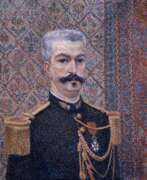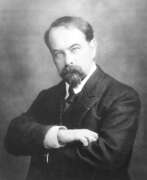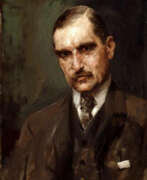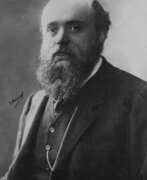Portraitist Pointillism


Albert Dubois-Pillet was a French Neo-Impressionist painter and army officer. He played an important role in founding the Société des Artistes Indépendants and was one of the first artists to embrace Pointillism.
Albert Dubois-Pieu's paintings often depicted landscapes, seascapes and city scenes, conveying the effects of light and atmosphere with meticulous attention to detail. His use of vivid and contrasting pointillistic colours created a sense of depth, brightness and optical blending when viewed from a distance.
Dubois-Pieu was influenced by the theories of colour and light of Georges Seurat and Paul Signac, two prominent figures in the Neo-Impressionist movement. He participated in several exhibitions with these artists and other members of the movement, contributing to the dissemination and appreciation of Neo-Impressionism.


Henri Eugène Le Sidaner was a French painter known for his intimate, atmospheric landscapes and still-life paintings. He was born in Port Louis, Mauritius, but grew up in northern France and studied art at the École des Beaux-Arts in Paris.
Le Sidaner's early work was influenced by the Impressionists, but he later developed his own distinctive style characterized by a subdued palette, soft brushwork, and a focus on capturing the effects of light and atmosphere. His paintings often depict gardens, parks, and rural landscapes, as well as interiors and still-life arrangements.
Le Sidaner was also known for his use of light and shadow, which he used to create a sense of depth and mood in his paintings. He was particularly interested in the way that light and shadow interacted in interior spaces, and many of his paintings depict quiet, contemplative scenes bathed in a soft, diffuse light.
Le Sidaner's work was widely exhibited during his lifetime, and he received many awards and honors, including the Legion of Honor in France. His paintings are now included in many important collections, including the Musée d'Orsay in Paris and the Metropolitan Museum of Art in New York.


Georges Lemmen is a Belgian Neo-Impressionist painter, member of the XX Society. He was close to art from childhood and studied for a time at a special drawing school. In the early 1880s, as a teenager, he was introduced to the work of Edgar Degas and Henri Toulouse-Lautrec, which had a great influence on him.
Georges Lemmen's paintings were marked by the use of fine, clean strokes and a vivid colour palette. He used the technique of divisionism, applying strokes of pure colour in close proximity to one another to create a sense of optical blending and luminescence.
Lemmen's subject matter was varied: landscapes, portraits, interiors and scenes of everyday life. He often portrayed leisurely pursuits and the beauty of nature, infusing his work with a sense of tranquillity and harmony.
Until 1895, he abandoned pointillism to contribute to the development of Belgian Art Nouveau. He created many book illustrations, posters, ceramics, carpets, drawings, pastels and gouaches in this style.


George Morren or Georges Morren was a Belgian painter, sculptor, Impressionist and engraver. The painter and friend of the family Emile Claus who taught him and his brothers several times a week served as his first mentor. He began working in an Impressionist style. In the summer of 1892, eschewing the shortened painting process which was associated with Neo-Impressionism, he began to work in a more spontaneous manner, creating more space for emotions. He became one of the most eager admirers of the French Impressionists. After three years in Paris he returned to Antwerp where he participated in several avant-garde groups. Morren created light-flooded paintings, exhibited at the fairs La Libre Esthétique in Brussels, the 'Vie et Lumière', and at numerous international exhibitions. Towards 1913, he entered a new creative period. The colors in his new works were more subdued. He used grated rough pigment and pastels. Morren remained faithful to impressionist ideals and did not participate in new trends, such as Cubism or Expressionism. He dealt with the scenes of everyday life, interiors, still lifes, landscapes and portraits. His palette became darker and his paintings developed a solemnity and clarity of expression.


Hans Olde was a German painter of the late nineteenth and early twentieth centuries. He is known as an impressionist painter and graphic artist, as well as a teacher and administrator.
Olde produced images of people, animals, landscapes, portraits and genre paintings, experimenting with pointillism. He was one of the founders of the Munich Secession and directed the Saxon Higher School of Art in Weimar. In 1911 the master became head of the Academy of Art in Kassel, playing an important role in the development of both the Weimar and Kassel academies, introducing reforms in the teaching process and supporting the admission of women artists. Olde had a significant influence on the development of the art of his time.


Jean Puy was a French painter associated with the Fauvist movement, known for his colourful and colourful works.
Jean Puy's early work was influenced by Impressionism, but he later adopted the bold and expressive use of colour characteristic of Fauvism. Inspired by artists such as Henri Matisse and André Derain, Puy developed a unique style that emphasised the emotional and decorative qualities of colour.
Puig's paintings often depicted landscapes, still lifes and scenes of everyday life. He was particularly interested in conveying the effects of light and colour in his works, using intense and unnatural colours to show mood and expression.
During his career, Puig exhibited at the Salon d'Autumn and the Salon des Artistes Indépendants, which were important exhibitions of avant-garde art in Paris.


Fernand Verhaegen was a Belgian painter and etcher. He took courses at the Académie Royale des Beaux-Arts from 1900 to 1906. After graduation, he exhibited his works in Belgium and abroad. His style gradually evolved from impressionism and Belgian luminism to a synthetic form of capturing reality. In his later years, he came back to a personal form of impressionism. Verhaegen specialized in painting Walloon folklore. Verhaegen's works are in many museums of Belgium and abroad.


Edmond Paul Marie Verstraeten was a Belgian painter and etcher. He was a luminist impressionist and painted mainly landscapes, but also still lifes and portraits. As a philosophically inclined non-conformist, Verstraeten painted in the direction of pointillism, impressionism and luminism. As a self-taught artist, he had developed his own style, which art critics classed as luminist impressionism. He was a master at painting the light and snow. He was part of the third generation of the School of Tervuren and Genk School. He also wrote poems.



